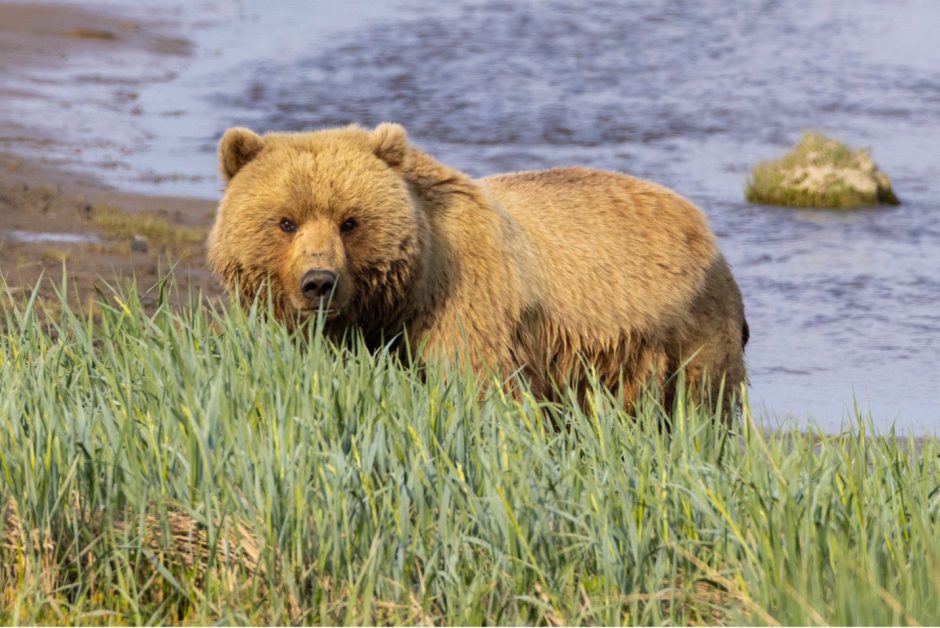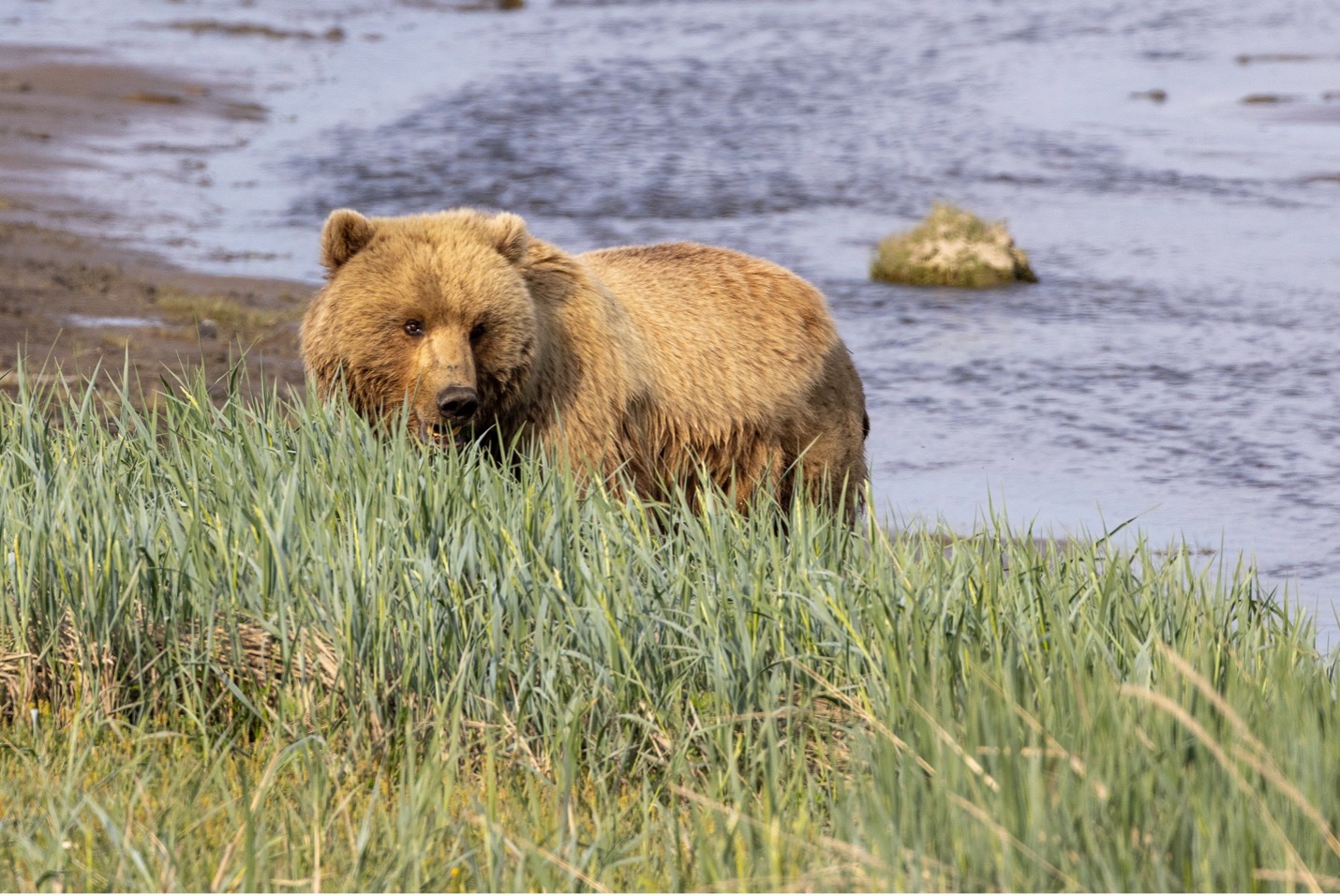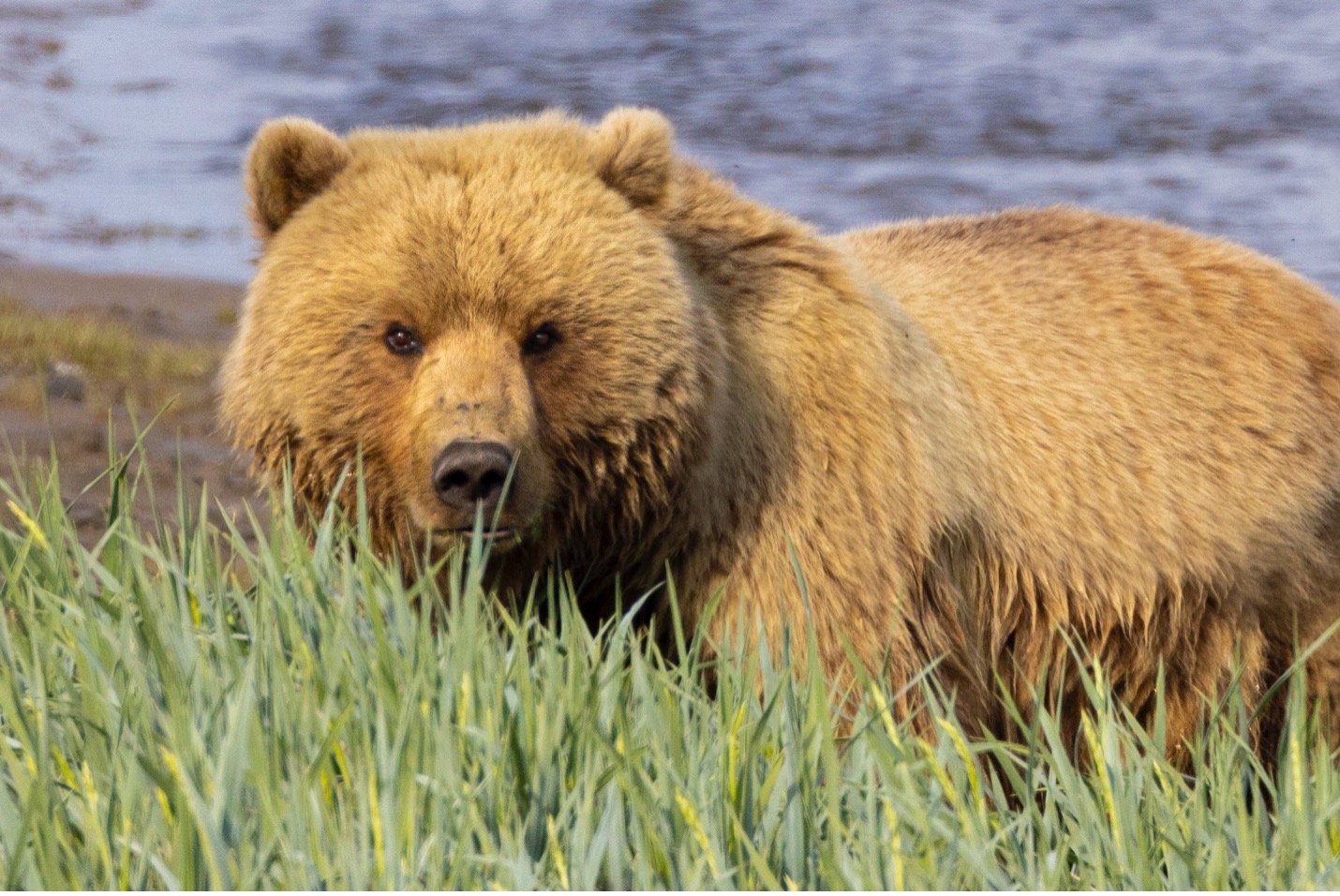
How to Get this Shot – Brown Bear Portrait
Alaska is the global epicenter of brown bear photography. Sure, you can get great grizzly photos elsewhere, but the volume and proximity of brown bears in Alaska, particularly in the “Bear Coast” area of central, coastal Alaska and places like Lake Clark National Park are out of this world.
In order to get that “classic” bear-in-its-natural-habitat shot, and to go above and beyond with your brown bear photography, follow the steps below to get the shot above, but these are easily translatable for nearly all brown bear photography in Alaska.
Getting in Front of Bears
Being in the right place at the right time is a huge part of the setup in the above photo. This classic “wildlife portraiture” photo requires close distance, as well as near-ground level angles to make it work.
In addition, you’ll want to ensure you’re in a place that can give you some interesting foreground elements regardless of how close the bears are.
While there are many opportunities for close-up bear photography, including such localities at Brooks Falls, and Geographic Bay, this photo happens to be from one of the least visited National Parks in the US—Lake Clark National Park. Based out of Nat Hab’s Bear Camp is a treat, as it gives you close viewing with comfortable accommodations that are only a stone’s throw away from the premier viewing spots circled around camp.
Camera Angle and Behavior
This is a two-part section, but each are equally important in terms of anticipating the bear’s movement and doing your best to get a low angled shot. Or, if you can’t photograph from ground level or close to it, actually prioritizing a greater distance with a bigger telephoto can help reduce the angle between you and the bear.
The key takeaway here is that if the bear is looking up at you, there is less of a connection with the animal and it’s just not as compelling of a photo as when you appear to be on eye level. Sometimes you don’t have a choice, but in those cases when you do–try and lower that angle.
The second part of this is having some patience to wait for a single moment for the bear to exhibit some sort of interesting behavior. It doesn’t always have to be the bear looking at you, the photographer. Sometimes as the bear looks side to side a glimmer of catch light will reflect from its eye, making a lovely photo, too.

The takeaway here is that there will be certain moments when the bear is more photogenic than other moments.
Yes, you can just rapid fire and take 100s of photos in a matter of seconds, but being a tad more deliberate and waiting for that special moment can mean a better photo in the end, not to mention fewer photos to sort through later!
Composition
Here is perhaps the most valuable tip I’ll share in this entire article.
When you are photographing moving wildlife…exciting wildlife…bears…make sure you take some shots wider than you think you should. That is—zoom out!
It’s oh so tempting to fill the frame with the animal and to look at it in the back of your camera and marvel at the sharpness and how great it looks…in the back of your camera.
However, once you get it on a computer, you’re going to realize that you didn’t necessarily need the photo to be that big. Trust me, I’m a proponent of “big” photos, but providing some foreground or background, like grasses and coastline, helps add context to the photo and will be part of the storytelling element.
Plus, with most modern cameras, you can always crop in a tad after the fact if you really want to fill the frame with the bear.

An equally important reason to shoot wider is that in the moment, while you’re photographing, it may be hard to really nail the composition. That is, if you are aiming for the rule-of-thirds or similar, in the flurry of the moment, you may be off…slightly off, or even way off.
By having that extra room to crop and recompose on the computer you are giving yourself the luxury of being able to take a second crack at composition.
Camera Settings
Your camera settings don’t need to be too specific, but you’ll want to achieve a couple of things.
First, you’ll want to have a nice sharp bear with perhaps some blur in the fore and background. For this, an aperture in the range of f/5.6 to f/8 is great. And a telephoto lens in the range of 400mm is ideal. 500mm is certainly helpful, but the point is that usually 300mm isn’t quite enough for the effect we’re going for here.
If you are fortunate to have a lens that will get you down to f/2.8 or f/4, do try those apertures, but depending on exactly how close you are you might find that these are just too shallow for the effect you’re going for. Be careful about how much is in focus. If the bear’s nose is in focus, but the eyes are not, or if the eyes are in focus, but the ears are not, you may have too shallow of a depth of field.
Second, you’re going to want to freeze motion with a fast enough shutter speed. A blurred animal won’t look artsy or creative here—you really want all motion frozen.
The exact shutter speed to achieve all this depends on a lot, but a 1/800 shutter is usually quite satisfactory. If you’re finding that you are in low light conditions, try 1/400 or 1/500. But be sure to review your photos to ensure sharpness, as nothing is worse than shooting a fantastic sequence for minutes of bear behavior only to find out that they’re all slightly blurry because you weren’t shooting fast enough.
Possible Variations
Bear behavior can change quickly, so be ready for anything! They might pick up on a scent and turn directions, another bear may approach too close, or the bear could chase after a salmon running upstream.
All of these provide you with additional photo opportunities with near similar methodology and shot settings. Just keep in mind the faster the movement, the faster your shutter speed will need to be (1/2500 freezes just about everything, but is also relatively limiting in terms of light…but mid-day in Alaska tends to be rather forgiving).
Alaska’s bears are always a highlight of my year photographing wildlife around the world. If you’re headed up there to capture these majestic critters, be sure to take these lessons with you and you’ll return home with stunning photos each and every time.
Cheers!

Court
Leave a reply